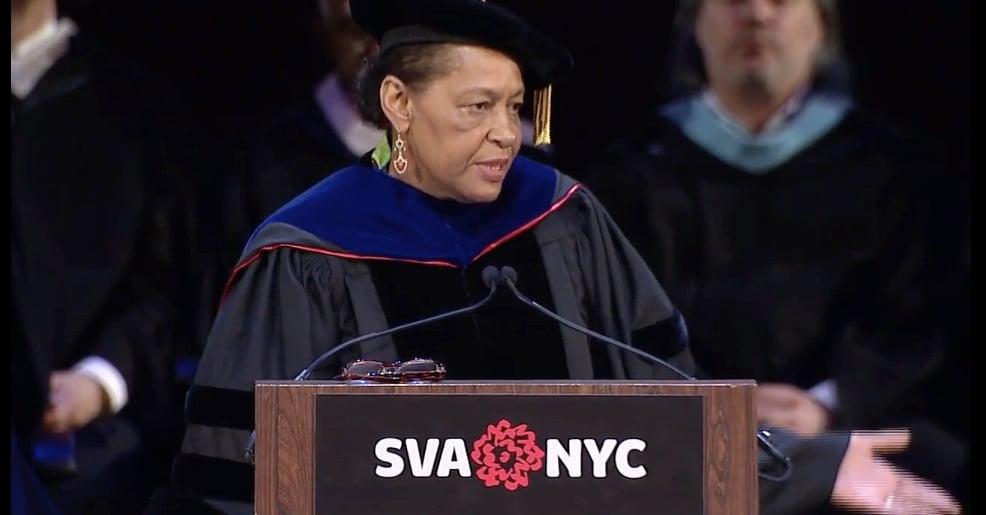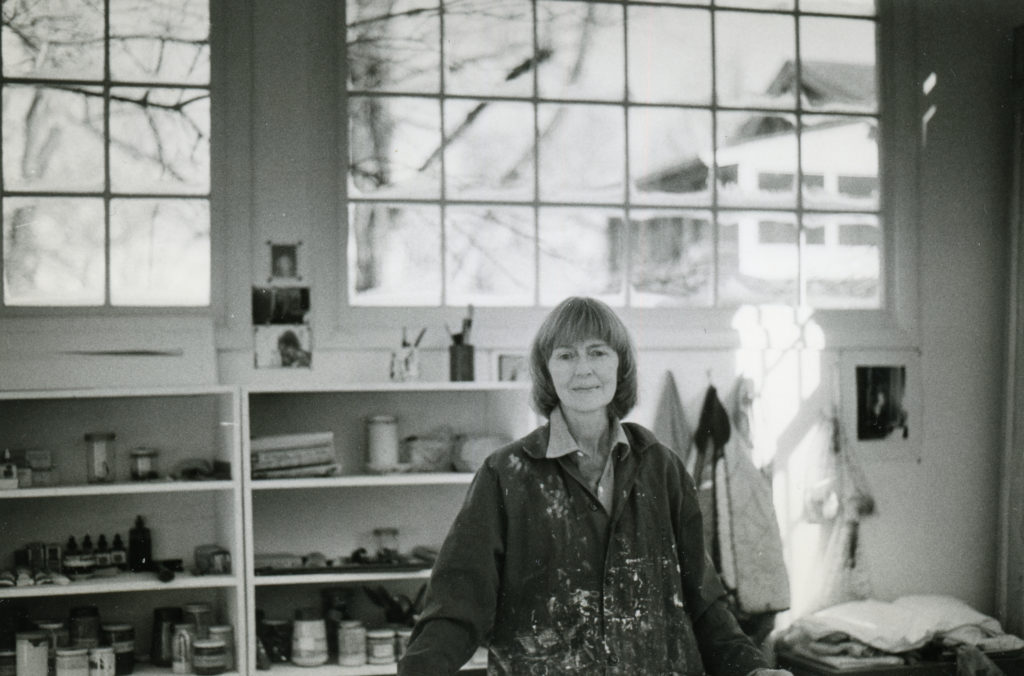Art World
Missing Graduation? Here Are 8 Inspiring Commencement Speeches From Carrie Mae Weems, Dana Schutz, and Other Artists Throughout History
In-person ceremonies may be cancelled for now, but these artists' wisdom is timeless.

In-person ceremonies may be cancelled for now, but these artists' wisdom is timeless.

Over the weekend, Barack Obama delivered two virtual commencement speeches to all the graduating students who cannot attend ceremonies in person this year.
“Build a community,” he advised. “Stand up for one another’s rights. Leave behind all the old ways of thinking that divide us—sexism, racial prejudice, status, greed—and set the world on a different path.”
Art schools, too, are staging virtual commencements this year, even some with celebrity appearances, such as John Waters at the School of Visual Arts on May 27.
To honor this year’s graduating artists, we’ve looked back on some of the most stirring commencement speeches at art schools throughout history.
Below, watch, listen, and read addresses from Glenn Ligon, Carrie Mae Weems, Dana Schutz, and more.
Watch part two of Saville’s speech here.

Anne Truitt, Washington DC, 1978. © annetruitt.org, courtesy of Matthew Marks Gallery.
Artist’s lives are adventures into territory as uncharted as that of Daniel Boone, who, when asked whether he had ever been lost in the wilderness, replied, “No—but I once was bewildered for two weeks!”
You also will be bewildered now and then, for an artist’s life is predicated on a subtle attunement to an unknown self, and none can guess where that unknown self will lead. Creative work is a matter of listening attentively to yourself, even if what that self is saying seems to you—and to everyone else—utterly outlandish. It is a fascinating way to live, because if you listen to your particular inner voice and follow it courageously, you will learn to trust that voice more and more—and you will surprise yourself afresh for as long as you live.
In your adventuring explorations you will be for some years in apprenticeship to yourself. It takes a lifetime. This is a delicate and demanding discipline, and I beg of you that you give yourselves time; do not expect quick results. In his Letters to a Young Poet, the great German artist Rainer Maria Rilke wrote, “A work of art is good if it has sprung from necessity…. Go into yourself and test the depths in which your life takes rise: at its source you will find what you must create. Accept it without trying to interpret it.”
The work in art that you will do in your future may be very different from that in which you are currently engaged. I hope that it will be very different, for your future work in art will in its unpredictable course reflect and refract the unpredictable course of your lives, of what those lives will teach you if you learn from them with open-minded passion. The artists who disappoint themselves are those who build intellectual and psychological fences around their expectations, who preconceive their work too narrowly. For if you preconceive who you are, you can only create what rises out of a self you have already defined as “correct.”
This not only discourages and limits the possibility of brand new concepts erupting into your work, but also deprives you of the value of learning how to be tough on yourselves, to endure, to rise above failed aspirations—which usually turn out to have been steps toward an unguessable goal. I urge you to preconceive as little as possible. Accept yourselves as strangers to yourselves, and let these strangers teach you who you are in the process of becoming as you move from one stage in your development to the next. Have faith in what your work is teaching you, and stand fast in that faith no matter what storms of criticism or praise rage around you. Both can be equally destructive.
I have found it useful to maintain the checks and balances of what Sigmund Freud called “reality testing.” To examine carefully what intelligent people have to say about my work, but always to retain a distance within which to judge for myself. And I firmly believe in addition: include every human experience that comes your way—personal relationships of all sorts, responsibility for children, all that sustains and deepens your heart. For the work you make will evolve—and you yourself evolve—only to the extent that you choose expansion rather than contraction.
Courage is the stoutest root of art.
If you maintain your independence you may find yourselves out in left field, obsessed by concepts that bear little or no relation to what people in general think that art is, should be, or could be. I have observed over and over again that spontaneous, original concepts arise equipped with all they need to become actual. They are accompanied by new—even astonishing—ways and means.
A second salient fact about innovative concepts is that they result in work that is magnetic. Work of authentic originality and value automatically attracts notice. I urge you to pay no more than intelligent attention to the work that you find around you as you move into the arena.
A current fashion in art is always leavened by the taste of the majority, and the taste of the majority is always conditioned by excitements that bear only oblique relation to the powerful current of ever-changing original conceptualizations of truth, the current in which genuine artists move and to which they contribute. Place yourselves squarely in this current, and learn to swim there. It is in the company of your contemporaries that you will find challenge. And courage, and comfort too. For individual aspiration is quintessentially a lonely endeavor. Loneliness comes with the territory, and you will devise ways to fortify yourselves while you learn to live there.
Last week I spent some time at the Whitney Biennial and thought of your good fortune in moving out into a situation so rich in possibilities. You come to it equipped with a range of technical and intellectual tools. You are, I am sure, well-founded there, and it seems to me that I might serve you best by speaking personally about what a lifetime in art has taught me about living the life of an artist. For artists are their own stock-in-trade: they make their work out of themselves, and this presents them with a challenge.
In the first place, they are adventurers into territory as uncharted as that of Daniel Boone. This fact presents them with a special challenge: that of making their work out of the material of their lives while they are living them. So that the art of making art and the art of living in such a way that a lifetime distills into their work are mutually dependent. The authenticity of their lives guarantees the authenticity of their art. And this authenticity rises from a bedrock of honesty to individual experience and a high heart.
Do not compromise your ideals for yourselves. This will take fidelity and a special kind of patience, and grit. Sheer luck comes in somewhere in how your work fares, but to a degree luck can be made. Place yourselves in situations rich with possibilities. If two cars collide on an empty road, the results are limited; if they collide on a Los Angeles Freeway at 5:30 p.m. on a workday, a great deal happens.
A long life in art has led me to the understanding that its rewards are secret. There is no worldly recompense commensurate to the cost of a lifetime of work. But that cost is as nothing when considered in the light of the exhilaration of trying to make what is true for yourself real for other people. Artists’ lives are essentially generous: they give themselves away. And in rendering their aspirations available to humankind, they render a noble service to our common life on this planet.
For you will, in a real sense, be making your own mind’s world visible in your work. This is a privilege, and like all privileges involves responsibility. Any action—and making art is a very complex action—leads to incalculable, unpredictable results, and these results are in themselves actions. All these actions accumulate over the years and, like money in a bank, accrue interest. If they have been honest they gain in value. Not only in the evolution of the artist’s work, but also in the evolution of the artist as a person—in unalienable spiritual value.
I close with a quotation from Pericles, who wrote these words in Athens in the fifth century BC: “For the whole earth is the sepulcher of people, and their story is not graven only on stone over their native earth but lives on far away woven into the stuff of other people’s lives.”
I wish you all, with all my heart, noble lives.